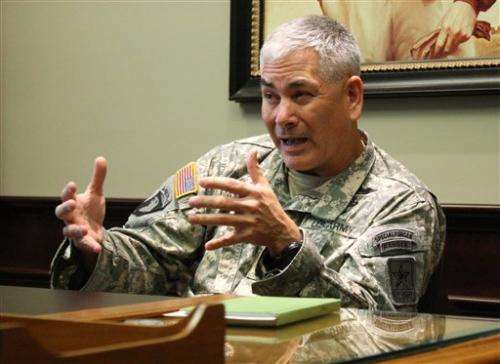US Army leaders defend flawed intelligence system

Gen. John Campbell, the U.S Army's vice chief of staff and nominee to lead U.S. forces in Afghanistan, cited his son's experiences as a soldier there to answer a senator's tough questions last year about a troubled intelligence technology system.
But after an inquiry from The Associated Press, the Army acknowledged this week that Campbell misspoke. He also omitted key facts as he sought to defend a $4 billion system that critics say has not worked as promised. Campbell will likely face more questions about the intelligence system at his confirmation hearing on Thursday. If confirmed, he heads to Afghanistan, where gathering and making sense of intelligence will remain a priority even as U.S. troops draw down.
Army leaders, including Campbell and his boss, Army chief of staff Gen. Ray Odierno, have circled their wagons around the Distributed Common Ground System, known as DCGS-A , a network of crash-prone software, sensors and databases that was supposed to allow troops to process and integrate intelligence from a variety of sources, from electronic intercepts to overhead imagery to spy reports.
A series of independent government reports have pointed to significant weaknesses in DCGS-A.
When Rep. Duncan Hunter, a member of House Armed Services Committee, visited troops in eastern Afghanistan last year, "DSGS was shut down in the corner, piled with books and papers," he said.
The Army has continued to pour money into the system despite its record of blown deadlines and unmet promises. Even more troubling to critics is how the army has sought to block commanders from using an off-the-shelf commercial product that soldiers say is more workable and user-friendly than DCGS-A, even though the commercial system has been embraced by the Marines, special operations forces, the CIA and other government agencies.
Army officials acknowledge problems with DCGS-A. In a statement, spokesman Matthew Bourke said the Army is working to improve the system in its next generation, which is being put out for bids next year.
DCGS-A was first developed a decade ago, but the spotlight on its shortcomings grew brighter in 2010, when Lt. Gen. Michael Flynn, then the top military intelligence officer in Afghanistan, said in a memo that "intelligence analysts in theater currently do not have the tools required to fully analyze the tremendous amounts of information currently available."
Flynn made an urgent request for a "theater-wide, Web-based analytical platform" that sounded a lot like a product offered by a Silicon Valley startup called Palantir, which grew out of antifraud technology developed by PayPal and was valued in December at $9 billion.
Yet over the last four years, records show, Army leaders have made it difficult for some commanders to purchase Palantir.
Army units that have managed to obtain Palantir report that it has saved lives in Afghanistan by helping to map insurgent activity and bomb networks in ways the Army system could not. It is also far cheaper: A 2013 Government Acountability Office report estimated that the Pentagon had spent about $35 million in recent years to equip the Marines and some army units with Palantir, compared to $4 billion for DCGS-A.
Palantir can merge disparate data sets—cellphone calls, fingerprint and DNA records, photos, bomb incident reports—and array them on a map in seconds. DCGS-A's work stations employ a mapping program that is much more difficult to master, in a system that does not allow seamless data fusion. When soldiers update a file in Palantir, that file becomes visible to every Army Palantir user, which often is not the case across the DCGS-A network.
Discover the latest in science, tech, and space with over 100,000 subscribers who rely on Phys.org for daily insights. Sign up for our free newsletter and get updates on breakthroughs, innovations, and research that matter—daily or weekly.
Last April, Sen. Claire McCaskill, a Democrat, confronted Campbell with DCGS-A's litany of troubles, including that the Army's testing lab in 2012 found the system "not operationally effective, not operationally suitable and not survivable."
Campbell said Palantir does only a small portion of what DCGS-A is supposed to do, though he acknowledged that it is easier to work with. The Army's system, he said, "saves lives" and has access to more intelligence than Palantir's software does.
He added, "My son is a soldier in the 82nd. He's a specialist. He deployed to Afghanistan." Cambell said his son was in "one of the units that asked for DCGS—or his brigade did, not himself."
Emails obtained by the AP show, however, that the younger Campbell's unit_the 82nd Airborne Division's First Brigade Combat Team_found the Army system inadequate and requested Palantir after six men died in two roadside bombs in April and May of 2012.
.
© 2014 The Associated Press. All rights reserved.

















